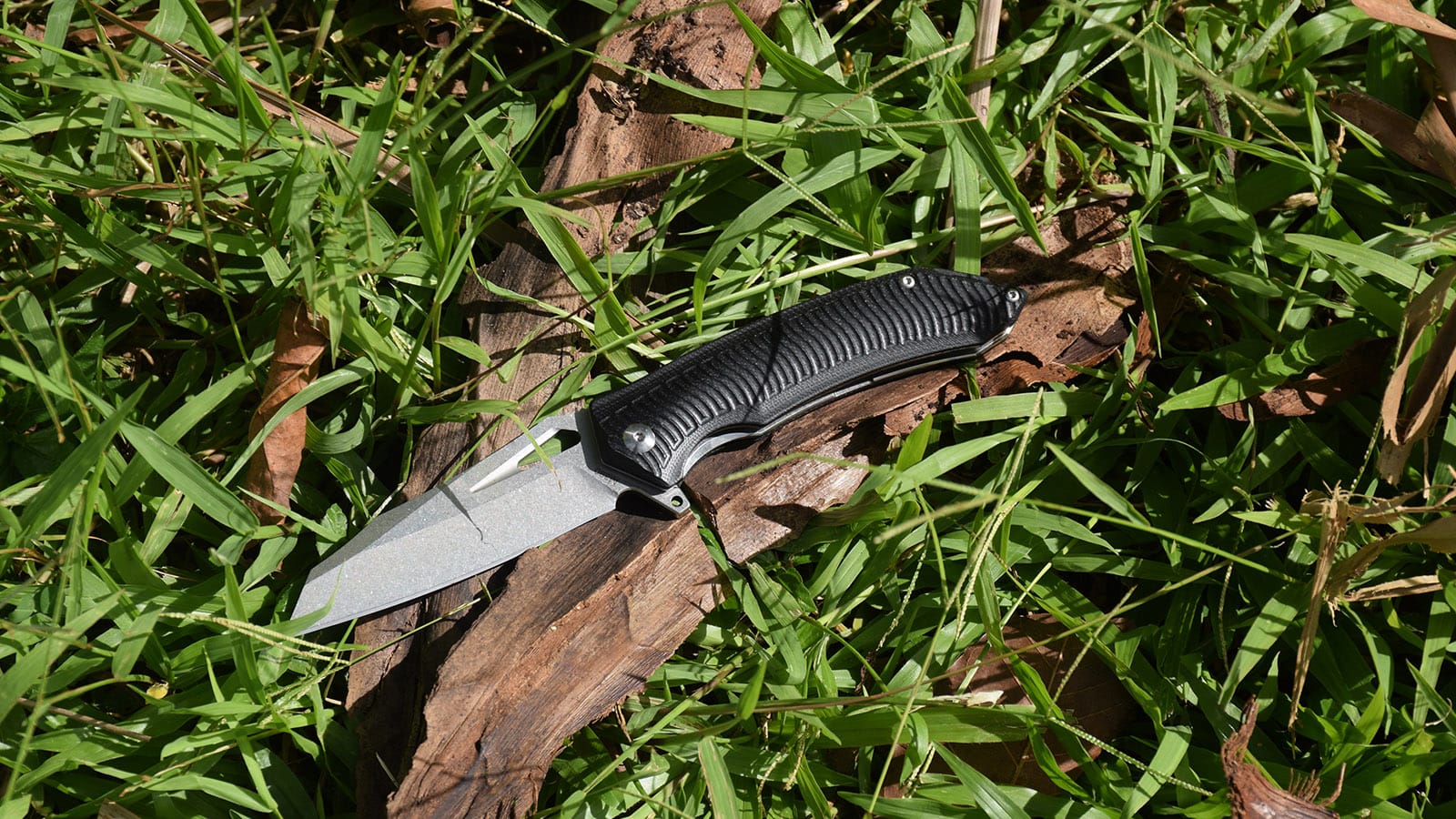Taskuveitset ovat monipuolisia työkaluja, jotka ovat olleet jokapäiväisen kuljetuksen (EDC) perusvarusteena vuosisatojen ajan. Olitpa sitten ulkoilun harrastaja, tee-se-itse-harrastaja tai vain joku, joka arvostaa hyvän veitsen hyödyllisyyttä, taskuveitsen oikea avaaminen on välttämätöntä. Tämä opas opastaa sinut läpi eri avausmekanismeja, turvallisuusnäkökohtia ja vinkkejä, jotka auttavat sinua hallitsemaan taittoveistäsi. Perinteisistä kynsileikistä nykyaikaisiin räpyläkielekkeisiin, katamme kaiken, mitä sinun tarvitsee tietää taskuveitsen avausmekanismeista.
Miksi taskuveitsen oikea avaaminen on tärkeää?
Ennen kuin sukeltaamme yksityiskohtiin, on tärkeää ymmärtää, miksi taskuveitsen avaamisen taidon hallitseminen on tärkeää:
- Turvallisuus: Oikea tekniikka vähentää tahattomien viiltojen riskiä.
- Tehokkuus: Nopea ja sujuva avaaminen mahdollistaa välittömän käytön tarvittaessa.
- Pitkäikäisyys: Oikea käsittely säilyttää veitsen mekanismin ja reunan.
- Laillisuus: Joillakin alueilla veitsen avaaminen voi vaikuttaa sen lailliseen asemaan.
Nyt tutkitaan erilaisia menetelmiä ja mekanismeja taskuveitsen avaamiseen.
Mitkä ovat yleiset taskuveitsen avausmekanismit?
Taskuveitsissä on useita avausmekanismeja, joista jokaisella on omat ainutlaatuiset ominaisuutensa. Tarkastellaan joitain suosituimmista tyypeistä:
1. Kuinka perinteinen liukunivelveitsi avataan?
Perinteiset taskuveitset, joita usein kutsutaan liukunivelveitseiksi, ovat klassisia taittoveitsiä, joiden kanssa monet meistä ovat kasvaneet. Näissä veitsissä on tyypillisesti naulan aukko avaamista varten. Liukuliitosveitsen avaaminen:
- Pidä veistä tukevasti hallitsevassa kädessäsi.
- Paikanna terän naulan kolo.
- Käytä pikkukuvaa nappaamaan naulan uurre ja vedä terä auki.
- Jatka vetämistä, kunnes terä lukittuu avoimeen asentoon.
Muista, että liukuliitosveitsissä ei ole lukitusmekanismia, joten ole varovainen käyttäessäsi painetta käytön aikana.
2. Mikä on paras tapa avata peukalopuukko?
Peukalonnastat ovat suosittu moderni avausmekanismi, joka tarjoaa nopean, yhdellä kädellä avautumisen. Veitsen avaaminen peukalon nastalla:
- Tartu veitsen kahvaan tiukasti hallitsevassa kädessäsi.
- Aseta peukalosi peukalon nastan päälle.
- Työnnä nasta pois kahvasta peukalolla.
- Kun terä alkaa liikkua, jatka painetta, kunnes se lukittuu auki.
Peukalon nastat ovat kaksikätisiä, joten ne sopivat erinomaisesti sekä oikea- että vasenkätisille käyttäjille.
3. Kuinka käytät Flipper-välilehteä oikein?
Flipper-veitset ovat tulleet yhä suositummiksi niiden sujuvan ja nopean käyttöönoton ansiosta. Flipper-veitsen avaaminen:
- Pidä veitsen kahvasta tukevasti kiinni.
- Aseta etusormesi kahvasta ulkonevalle räpyläkielelle.
- Vedä kielekettä takaisin nopeasti ja lujasti.
- Terä kääntyy ulos ja lukittuu paikoilleen.
Flipper-kielekkeet toimivat usein yhdessä kuulalaakeroitujen niveljärjestelmien kanssa, mikä takaa poikkeuksellisen sujuvan avaamisen.
4. Millä tekniikalla Spyderco-tyylinen peukaloreikä avataan?
Spyderco teki suosituksi pyöreän peukalonreiän avausmekanismin, joka tarjoaa erinomaisen otteen ja hallinnan. Peukalonreiällä varustetun veitsen avaaminen:
- Tartu veitsen kahvaan tiukasti.
- Aseta peukalosi terän pyöreän reiän sisään.
- Työnnä peukaloasi eteenpäin ja hieman ylöspäin kääntääksesi terän auki.
- Jatka liikettä, kunnes terä lukittuu paikalleen.
Peukalonreiät ovat erityisen hyödyllisiä käsineitä käytettäessä tai märissä olosuhteissa.
5. Kuinka avaat avusteisen avausveitsen?
Avustetut avausveitset käyttävät jousimekanismia, joka helpottaa terän avautumista, kun käyttäjä aloittaa avaamisen. Avausavusteisen veitsen avaaminen:
- Pidä veitsestä tukevasti kiinni.
- Aloita terän avaaminen peukalon nastalla tai läppäkielekkeellä.
- Kun olet voittanut alkuvastuksen, jousiavustin ottaa vallan.
- Anna mekanismin suorittaa avaustoiminto loppuun.
Valmistaudu nopeaan käyttöön ja suuntaa terä aina poispäin itsestäsi ja muista.

6. Mikä on painikelukkoveitsen avaamisprosessi?
Näppäinlukkoveitset tarjoavat turvallisen lukitusmekanismin ja mahdollistavat usein helpon käytön yhdellä kädellä.Näppäinlukkoveitsen avaaminen:
- Pidä veitsen kahvasta lujasti kiinni.
- Paikanna painikkeen lukko, yleensä kahvan sivulta.
- Paina ja pidä painiketta painettuna.
- Pidä painiketta painettuna ja käännä terä auki peukalollasi.
- Vapauta painike, kun terä on kokonaan ulos vedetty lukko lukitsemiseksi.
Painikelukot tunnetaan vahvasta lukituksestaan ja helppokäyttöisyydestään.
7. Kuinka avataan kehyslukko tai vuorauslukkoveitsi?
Runkolukko ja vuorauslukkoveitset ovat suosittuja vahvojen lukitusmekanismien ja tyylikkään muotoilunsa vuoksi. Kehyksen tai vuorauksen lukkoveitsen avaaminen:
- Pidä veitsen kahvasta tukevasti kiinni.
- Käytä mitä tahansa edellä mainituista avaustavoista (peukalotappi, läppä jne.) terän avaamiseen.
- Avaa terä kokonaan, kunnes kuulet tai tunnet lukon lukittuvan.
- Tarkista ennen käyttöä, että lukko on kunnolla kiinni.
Nämä lukot ovat vahvoja ja luotettavia, mutta ne vaativat asianmukaista huoltoa toimiakseen moitteettomasti.
Mitä turvallisuusvinkkejä taskuveitsien avaamiseen on?
Turvallisuuden tulee aina olla etusijalla veitsiä käsiteltäessä. Tässä muutamia olennaisia vinkkejä:
- Pidä terä aina suunnattuna poispäin itsestäsi ja muista.
- Varmista, että sormesi ovat poissa terän tieltä avattaessa.
- Pidä kahvasta tukeva ote luistamisen estämiseksi.
- Ole tietoinen ympäristöstäsi, kun avaat veitsen.
- Tarkista säännöllisesti veitsesi vaurioiden tai löystyneiden osien varalta.
- Pidä veitsesi puhtaana ja hyvässä kunnossa, jotta se toimii sujuvasti.
Kuinka voit parantaa taskuveitsen avaamistaitojasi?
Kuten kaikki taidot, taskuveitsen avaaminen sujuvasti ja turvallisesti vaatii harjoittelua. Tässä on joitain tapoja parantaa:
- Aloita hitaasti ja keskity oikeaan tekniikkaan ennen kuin yrität nopeutta.
- Harjoittele erilaisia avausmekanismeja tullaksesi monipuoliseksi.
- Opi avaamaan veitsesi jommallakummalla kädellä mukautumiskykyä varten.
- Ymmärrä veitsesi lukitusmekanismi huolellisesti.
- Harkitse veitsen turvakurssin suorittamista kattavaa koulutusta varten.
Mitä sinun pitäisi tehdä, jos taskuveitsesi ei aukea?
Jos sinulla on ongelmia taskuveitsen avaamisessa, harkitse näitä ohjeita:
- Tarkista, onko kääntöalueella näkyviä esteitä.
- Varmista, että lukitusmekanismi ei ole kytkettynä.
- Puhdista ja voitele nivel- ja lukituspinnat.
- Säädä nivelen kireyttä, jos veitsessäsi on säädettävä nivel.
- Jos ongelmat jatkuvat, ota yhteyttä valmistajaan tai ammattimaiseen veitsenvalmistajaan.
Onko taskuveitsien avaamisessa laillisia näkökohtia?
Taskuveitsiä koskevat lailliset määräykset voivat vaihdella huomattavasti sijainnistasi riippuen. Muutamia tärkeitä huomioitavia kohtia:
- Joillakin lainkäyttöalueilla on rajoituksia terän pituudelle.
- Automaattiset (switchblade) veitset ovat usein tiukkojen määräysten alaisia.
- Avaustapa (esim. yhdellä kädellä vs. kahdella kädellä) voi vaikuttaa laillisuuteen joillakin alueilla.
- Tutki aina veitsen kantamista ja käyttöä koskevia paikallisia lakeja ja noudata niitä.
Kuinka erilaiset veitsimallit vaikuttavat avausmenetelmiin?
Taskuveitsen muotoilu voi vaikuttaa suuresti sen avaustapaan ja käytön helppouteen. Tutustutaanpa joihinkin suosittuihin malleihin:
Perinteiset taitettavat veitset
Nämä klassiset mallit, kuten Sveitsin armeijan veitsi, vaativat usein kaksi kättä avatakseen ja voivat sisältää useita teriä tai työkaluja. Ne käyttävät tyypillisesti nauloja avaamiseen, eikä niissä ole lukitusmekanismeja.
Modernit taktiset taittoveitset
Taktiset veitset, kuten monet Kershaw mallit, on suunniteltu nopeaan, yhdellä kädellä avaamiseen. Niissä on usein peukalon nastat, räpylät tai avustetut avausmekanismit nopeaa käyttöönottoa varten.
Herrasmiesten kansiot
Nämä tyylikkäät veitset, kuten jotkut räätälöidyt damascus-veitset, voi asettaa esteettisyyden etusijalle nopean käyttöönoton sijaan. Niissä on usein naulanjäljet tai pienet peukalonnastat huomaamattomampaa avaustapaa varten.
Utility veitset
Utility veitset, kuten taitettava veitsi puisella kahvalla, on suunniteltu käytännöllisiksi ja niissä voi olla erilaisia avausmenetelmiä käyttötarkoituksensa mukaan.
Mikä rooli veitsen huollolla on helpossa avaamisessa?
Asianmukainen huolto on ratkaisevan tärkeää, jotta taskuveitsesi avautuu sujuvasti ja turvallisesti. Tässä on joitain tärkeitä huoltovinkkejä:
- Puhdista veitsi säännöllisesti lian ja roskien poistamiseksi.
- Pidä kääntöalue voideltuna sopivalla veitsiöljyllä.
- Kiristä löystyneet ruuvit, erityisesti nivelalueen ympäriltä.
- Teroita terä säännöllisesti välttääksesi tarpeetonta voimaa leikkaamisen aikana.
- Säilytä veistäsi kuivassa ympäristössä ruosteen ja korroosion estämiseksi.
Miten materiaalit vaikuttavat taskuveitsen avautumiseen?
Taskuveitsessä käytetyt materiaalit voivat vaikuttaa merkittävästi sen avautumistoimintoon ja yleiseen suorituskykyyn:
Käsittele materiaalit
- G10: Tarjoaa erinomaisen pidon myös märissä olosuhteissa. G10-kahvaiset taskuveitset ovat suosittuja kestävyytensä ja pitonsa vuoksi.
- Titaani: Kevyt ja korroosionkestävä, käytetään usein huippuluokan veitsissä.
- Puu: Perinteinen ja esteettisesti miellyttävä, mutta saattaa vaatia huolellisempaa huoltoa.
Terä terästä
- Ruostumaton teräs: Kestää korroosiota ja säilyttää hyvän reunan.
- Hiiliteräs: Kestää erittäin terävän reunan, mutta vaatii enemmän huoltoa ruosteen estämiseksi.
- Damascus Steel: Tarjoaa ainutlaatuisia kuvioita ja hyvän reunan pysyvyyden.
Pivot-järjestelmä
- Aluslevyt: Perinteisiä ja kustannustehokkaita, mutta eivät välttämättä yhtä sileitä kuin nykyaikaiset järjestelmät.
- Kuulalaakerit: Tarjoaa erittäin pehmeän avautumisliikkeen, joka löytyy usein huippuluokan veitsistä.
Mitä ovat kehittyneet taskuveitsen avaustekniikat?
Harrastajille, jotka haluavat hioa taitojaan, tässä on joitain edistyneitä tekniikoita:
- "Spydie Flick": Nopea avausmenetelmä Spyderco-tyylisille peukalonreikäveitsille.
- Reverse Flick: Veitsen avaaminen pyyhkäisemällä rannettasi pitäen samalla lukkoa.
- Slow Roll: Hallittu, tasainen aukko peukalon nastalla tai reiällä.
- Wave-ominaisuus: Joidenkin veitsien selässä on koukku, joka tarttuu taskuusi ja laukeaa automaattisesti vedettäessä.
Muista, että nämä tekniikat vaativat harjoittelua ja niitä tulee aina suorittaa turvallisuus ajatellen.
Johtopäätös: Taskuveitsesi hallitseminen
Taskuveitsen avaaminen turvallisesti ja tehokkaasti on jokaisen veitsen omistajan perustaito. Ymmärtämällä eri mekanismit, harjoittelemalla asianmukaisia tekniikoita ja huoltamalla veistäsi, olet hyvin varusteltu selviytymään kaikista tiellesi sattuvista leikkaustehtävistä. Muista, että avain hallintaan on harjoittelu ja työkalusi kunnioittaminen.
Tärkeimmät takeawayt:
- Aseta turvallisuus aina etusijalle käsitellessäsi taskuveistäsi.
- Ymmärrä veitsesi avausmekanismi ja lukitusjärjestelmä.
- Säännöllinen huolto takaa sujuvan ja luotettavan toiminnan.
- Harjoittele erilaisia avaustekniikoita parantaaksesi taitojasi.
- Ole tietoinen veitsen kantamista ja käyttöä koskevista paikallisista laeista.
- Valitse tarpeisiisi ja mieltymyksiisi sopiva veitsimalli.
- Oikea hoito ja tekniikka pidentävät taskuveitsesi käyttöikää.
Näiden oivallusten ja tekniikoiden avulla olet nyt valmis avaamaan taskuveitsesi luottavaisesti ja taitavasti. Käytätpä perinteistä liukuliitosta tai modernia räpylää, oikea tietämys ja käytäntö varmistavat, että voit aina luottaa luotettavaan taskuveitseesi, kun sitä eniten tarvitset.




